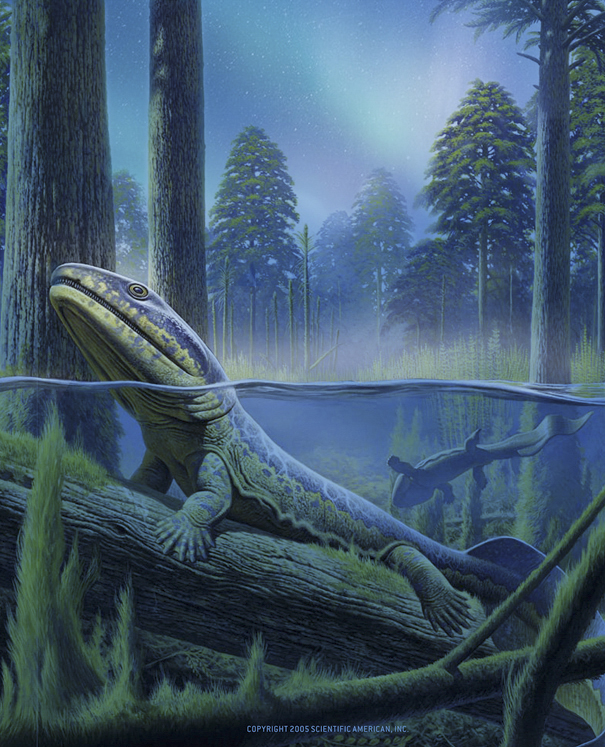If we trace our ancestory back through time we rapidly reach our four-legged ancestors (or tetrapods). And if we follow that line far enough, say to 360 million years ago (in the Devonian Period), we meet ancestors who were also the ancestors of elephants, kangaroos, canaries snakes and all other land living creatures with backbones – some of whom have later lost their legs!

World renowned expert on Devonian tetrapods, Prof Per Ahlberg from Uppsala University in Sweden recently gave a public lecture on these fascinating creatures at the Albany Museum in Grahamstown.
Ahlberg came to South Africa at the invitation of local palaeontologist Dr Rob Gess to examine important new unpublished clues from shale deposits found at Waterloo Farm next to the N2 highway. He gave an informative lecture on the origins of Devonian tetrapods about 400 million years ago. The lecture, entitled ‘Devonian tetrapods, when, where and how’ was well received, as it was crafted to be accessible to those who know little about palaeontology, yet interesting to the advanced enthusiast as well.
Devonian tetrapods were strange four-legged animals that over millions of years made the transition from living in water to living on land. The word tetrapod means ‘four feet’ – so why do birds only have two feet and snakes have none?
The answer is that the ancestors of both had four limbs, but in the case of birds, two of them evolved into wings while in the case of the snakes, all four limbs were lost in the process of evolution.
Ahlberg explained to the audience how a group of large lobe-finned fish gradually transformed into a peculiar animal that looked something like a salamander and maybe behaved a little like a mudskipper. This, he said, was one of the most pivotal moments in vertebrate evolution, and ecological history – as the impact of their descendants on land ecosystems has been enormous.
He reviewed traditional thinking on the evolution of tetrapods and noted that developments in the last 20 years, including the discovery of well-preserved intermediate forms, have pulled the rug out from under dated text books – that often described fish dragging themselves on to land. Rather, tetrapods developed gradually within the aquatic realm, probably exploiting the shallows around lakes and lagoons.
Until very recently, a series of forms from the Late Devonian of Europe, Greenland and North America (that formed a tropical landmass at the time) appeared to provide a neat sequence of forms that illustrated a greatly improved textbook account of the emergence of legged vertebrates. Intermediate forms (or ‘Élpistostegids’) had basic legs that still ended in fin webs rather than toes, lost their back fins and could move their heads like tetrapods. They had eyes on the top of their heads like alligators. Conveniently fossils of these creatures seemed to fall in age between those of conventionally fishy lobe-finned-fish, and the earliest tetrapods.
But as is often the case this neat new linear model has in turn been shaken up by new discoveries.
In the past five years, tetrapod track-ways from as early as the mid-Devonian have been identified in various parts of the world, indicating that known intermediate-type forms were living side by side with tetrapods. In addition, intermediate forms showing contradictory combinations of ádvanced’ and ‘primitive’ features have shown that the evolution of tetrapods is a lot more complicated, or ‘branchier’ than was earlier believed.
Ahlberg said it was not always a straightforward exercise to tell which tetrapod or elpistostegid developed earlier or which came later because some species were advanced in one particular aspect, while another species might be more advanced in completely different trait. It appears that the transition from fish to tetrapods was not an entirely linear progression.
He said that as scientists now have a clearer picture of the morphological changes in the transition period, more questions remain to be answered. He also suggested that more intriguing creatures are still to be found that might help to answer these questions.
Dr Gess has over the years discovered several remarkable fossils in the 360-million-year old black shale deposits he excavated from Waterloo Farm just outside Grahamstown. The fossils include, seaweeds and plants, a lamprey, a number of other fishes including a school of baby coelacanths and the pincer of an ancient scorpion. Per Ahlberg indicated that this site was unique for its age, a ‘lagerstatte’ in which the remains of an entire ecosystem are preserved.


